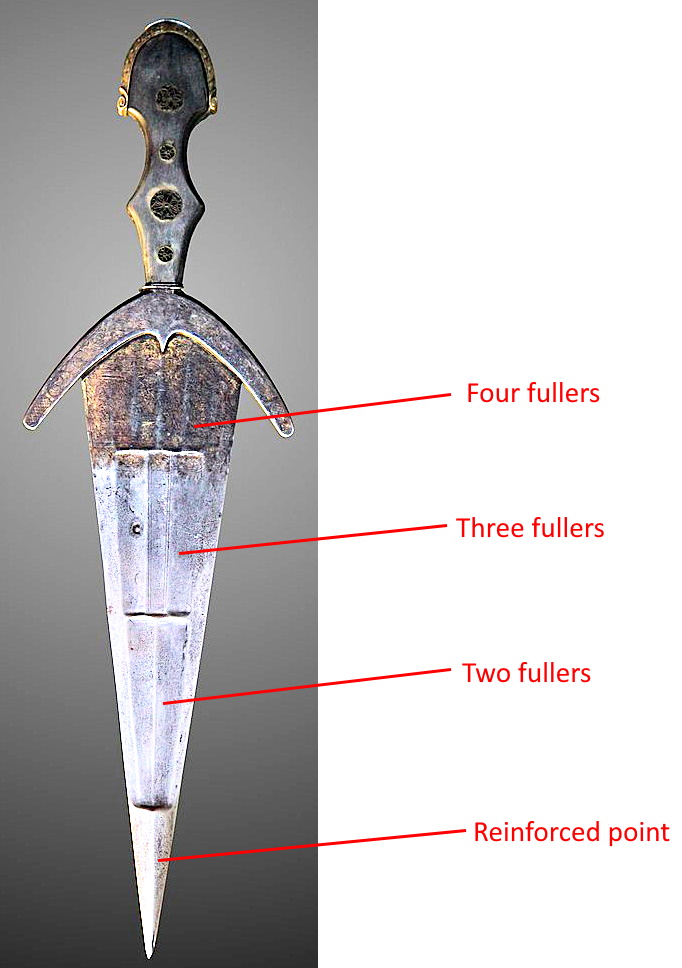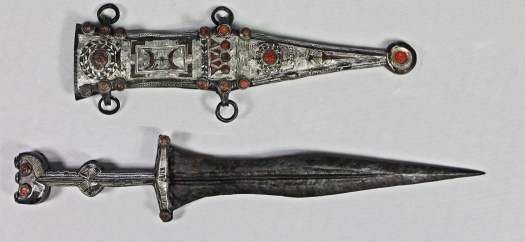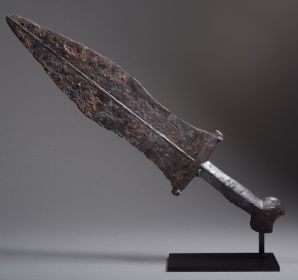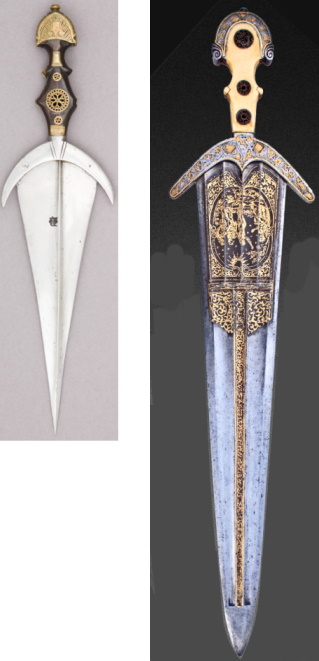The Cinquedea is a mysterious type of blade weapon which appeared in Italy during the second half of the 15th Century, and was largely gone by the second half of the 16th Century. During this period however, especially in the late 15th Century and early 16th, it was very popular, and thousands of examples were made. The characteristics can be generally defined as a bladed weapon with a very broad forte, the name referring to ‘five fingers’ width, and an overall triangular shape. Some, especially early on, are dagger sized, others are well into the short sword range. Some have very sharp points, others have spatulate or even rounded points. Nevertheless, the points are often reinforced, while the blades (particularly of the larger examples) are frequently lightened with a complex pattern of multiple fullers, often two or three layers of them.

The obvious purpose of the early cinquedea is to inflict wounds, and we know that a wide blade will cause particularly serious stab wounds. A sharply tapered shape allows a wide blade to punch into the body of one’s opponent or intended victim, thus reaching and damaging internal organs and blood vessels which should rapidly lead to death. This is the basic principle of the Roman ‘pugio’, itself a derivation of an earlier Hispanic type going back into the Iron Age.


But how much does the Renaissance cinquedea relate to the Iron Age weapons of Ancient Rome? Here we see a discussion of the Cinquedea from Dr Tobias Capwell & Matt Easton.
To me what is good about this discussion, and the best indication that these two individuals know what they are talking about, is that they admit that we don’t know that much about this interesting and rather mysterious weapon. If you want to understand anything from history, the starting point is to admit what you don’t know. But they also raise a few interesting points, some of which I agree with.
There is a likelihood that the cinquedea is linked to the ongoing and accelerating fascination by the late medieval Italians for their Classical era predecessors. They were digging up and collecting antique weapons, they were reading Greek, Roman and Persian treatises on war (and every other subject) and they were actively attempting to apply Roman tactics to Renaissance armies. There are also obvious links to antique weapons. As one example:


We can find both Bronze and Iron Age weapons which share many design features, notably the multiple fullering. Fullers on a sword can have an effect similar to an i-beam in construction, it enhances rigidity while removing mass, thus allowing a lighter weapon to still be firm and strong. This is particularly important for bronze or early ‘steely iron’ swords which were not as strong as steel, and thus sometimes required more mass. But fullers were also in wide use in the late medieval and Early Modern periods, I don’t think it’s something which is restricted to softer metals. The large cinquedeas have enormous, very broad blades, and to make that viable, they would have to be lightened.
I think Toby raises a good point that the hilts of cinquedea resemble those of some Bronze Age weapons. I’m not sure I buy the idea that any civilian defense weapon is a ‘rapier’, nor would I assume that the weapon was only used for thrusting. We have learned in the last twenty years as better and more accurate replicas have been made, that swords with a great deal of ‘profile taper’ i.e. those which are wide at the base and come to a sharp point at the tip, often cut very well. It’s not 100% clear why but it may be as simple as the wider blade providing more cutting mass at the point of percussion, or the taper itself converting some of the force of a percussive cut into something like a draw cut, the way a saber does.

Though Matt and Toby are careful not to make too many assumptions and point out that the cinquedea appear to be made with practical purposes in mind, the common assumption with weapons of this period that we don’t know much about, is to dismiss them as yet another odd manifestation of quirky medieval fashion. This is a subset of a vast historical trope and even a kind of school in Academia that emphasizes everything strange and odd about the medieval world. This is especially true for anything associated with the civilian world. But duels and street brawls in the streets of the Italian Renaissance City-States were not mere displays of elegance and wealth. They were often deadly serious and could decide the fate of great families, and even of the entire community. Italian burghers were competent, practical people who took martial arts and self defense very seriously indeed. And were quite good at it.
Modern people have assigned ‘fashion’ as 100% of the reason why people of the medieval period carried various types of arms and armor since I was a kid, usually with a sniggering layer of contempt over the irrationality of the medieval mind. 20th and 21st Century minds prefer to assign a single reason for almost everything. In the 15th Century, there was almost always multiple reasons. The cinquedea is a very complex weapon, clearly made for fighting. They have extraordinarily complicated blade shapes with multiple fullers, (sometimes as many as a dozen), they typically have reinforced points, and they are always sharp. It’s quite clear they were used in the same role as any other sidearm; i.e. for self defense, and there was also undoubtedly a fashion element. But there are many open ended questions as to how they were used.
There are Bronze Age weapons with this shape, and there are Iron Age weapons with multiple fullers, but the combination of all these traits in the Cinquedea is rather unique, and seems to have followed it’s own evolution as they became longer and more complex during the time they were used. The changes seem to be as much on a functional basis as fanciful. I would agree with Toby in his comment that they deserve a closer look. I also agree with Matt here that the baselard is a good comparison in terms of the social niche, but the cinquedea is arguably an order of magnitude more complex and ornate than the typical swiss baselard or ‘baselard-sword’.
The bottom line about these interesting blades is that we don’t know that much about them yet. They don’t show up in the fencing manuals and are even pretty rare in art, especially considering how ubiquitous the actual weapons are. This is another of many places where we find that the literary and artistic records are somewhat at divergence from the archeological / physical specimens left over from the time. I suspect we will learn more about them though simply because there are such a huge number of records, letters, court transcripts, memoirs and so on to be gone over from highly literate Renaissance Italy, and we’ll find more answers there.
My final commentary is of necessity, pure speculation, so take it with a grain of salt. I’d say the following: We know that the shape of these blades will cause devastating wounds with a thrust. The reinforced points tell us these were indeed probably used for thrusting. We also know that having so much of the mass concentrated near the hilt often, though not always, makes a sword a bit more nimble .This however also depends on things like the weight of the hilt and the distal taper of the sword (how thick the blade is vs. how wide) so we have to be careful about that assumption. We also know from replicas, for example Oaksehott type XV and XVa swords, that a wide, triangular shaped blade is good for cutting too. Especially a very wide one. The blade shape of a cinquedea is a lot like that of a partisan (polearm) which was used for cutting as much as thrusting.
But one other feature of a sword is defense. Swords and daggers kill and wound, but as the sword gets longer, the utility for defending against weapons becomes more prominent. Here the cinquedea are curious, the curved guard and relatively short quillions seem to imply that the hand may be exposed in a cut. In the Classical era and back into Antiquity, swords were often used with shields. Shields were sometimes used in urban brawls and civilian duels, but carrying a shield is something of a giveaway that you are looking for trouble. One of the biggest questions for me regarding the cinquedea is how were these used for defense, but as Matt might point out, you could ask the same question about the baselard and many other short swords, until the katzbalger with its big ‘figure 8’ hand guard becomes popular.
In part II of this post, we will talk to historian, fencer and swordsmith Dr. Fabrice Cognot to get some of his opinions on this mysterious weapon.
